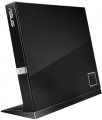Writes
The types of optical discs that the drive can handle. In this case, we mean read-only work.
Historically, CD came first, then DVD, and even later, Blu-ray. The general rule for compatibility of discs and drives is as follows: earlier types of discs are readable in later drives, but not vice versa, and discs of the same type (for example, DVD) are interchangeable (with rare exceptions, which are discussed below).
The specific types of carriers used today are as follows:
—
CD-R. Recordable (once) CD. The standard capacity is 700 MB. Supported by all modern drives, regardless of type.
—
CD-RW. The rewritable CD version (see above) is also readable by almost all modern drives.
—
DVD+R. Recordable DVDs. Technically they are divided into DVD-R and DVD+R, in fact they do not differ in almost anything. Standard capacity — 4.7 GB; double-sided and double-layer recording can reach 17 GB, however, dual-layer discs are not supported by all drives.
—
DVD+RW. Rewritable DVD version (see above). Both DVD-RW and DVD+RW are supported almost without limitation by the corresponding drives.
—
DVD-RAM. A special kind of rewritable DVD — designed for frequent rewriting, withstand 100 times more rewrite cycles than RW, however, unlike other DVDs, they are not
...readable by all DVD drives. Initially, they were produced in protective cartridges, but later disks without cartridges and drives for them appeared; the possibility of operation of the drive with a cartridge should also be specified separately in each case.
— BD-ROM (Blu-Ray). High-capacity optical discs, originally designed to store high-definition video. The standard capacity is 25 GB, there are double-layer versions of 50 GB, but they are not supported by all drives. The index "ROM" means the impossibility of recording.
— BD-R (Blu-Ray). Blu-ray discs (see above) with write-once capability.
— BD-RE (Blu-Ray). Rewritable (Recordable Erasable) version of Blu-Ray discs (see above).Interface
Type of connection of the drive to the computer.
— IDE. Standard for connecting internal (see "Type") optical drives. Provides data transfer rates up to 1 Gbps and allows you to connect up to three devices per loop (two full-function and one read-only). For a long time it was the main one for PCs, but today it is considered obsolete and is being replaced by the faster and more reliable SATA.
—
SATA. The most common modern standard for connecting internal (see "Type") drives; replaced IDE, it has a higher data exchange rate (up to 5.9 Gbps, depending on the version) and resistance to interference, but does not allow connecting more than one device per loop.
—
USB 2.0. The most common modern standard for connecting various external peripherals to a PC, including and optical drives. The vast majority of PCs and laptops are equipped with USB ports, due to which external drives with this interface are the most versatile today. Version 2.0 provides data transfer rates up to 480 Mbps.
—
USB 3.2 gen1. A version of the standard that provides data transfer rates up to 5 Gbps. Previously labeled as USB 3.1 gen1 and USB 3.0.
eSATA. A type of SATA interface designed to connect external (e — external) drives. Not compatible with regular SATA. The data transfer rate is up to 2.4 Gbps, which is significantly higher than that of USB 2.0 (a
...nd 3.0 appeared significantly later), but the interface itself is less versatile and, as a result, much less common.DL (for DVD)
Possibility of operation of the drive with
two-layer DVD-discs(see "DVD±R"). The use of two layers for recording information doubles the capacity of the disc, but such media is only compatible with special drives.
DL (for Blu-ray)
Ability to drive
dual-layer Blu-Ray discs(for details, see "
BD-ROM (Blu-Ray) ")
Vertical mount
A variety of external (see "Type") drives for which
operation in a vertical position is allowed. With this installation, they take up less space on the desktop and can significantly save space. At the same time, it is possible to work in a horizontal position.
Disc loading
—
Retractable. Drives with this type of loading are equipped with a drawer, which is controlled by a built-in electric motor — for its extension or loading, just press a button. This is the standard boot mechanism for most internal drives used in PCs (see "Type").
—
Retractable manual. In such drives, the button is used only to unlock the drawer — you have to pull it out and load it back manually. This loading mechanism is widely used in laptop drives (both internal and external), as it does not require power to load and unload the drive and saves battery life.
—
slotted. In such drives, the disk is loaded through a special slot in the case: the disk is inserted there somewhere up to half, after which it is picked up by a special mechanism and placed inside the drive; extracted in the same way. It is used mainly in slim-variations of drives, both internal and external (see "Type").
—
Manual. Drives with this loading have a disc compartment with a lid, similar to CD players. Opening the cover, inserting and removing the disc is done manually. Used in external drive models, can also be used in laptops. (see "Type").

